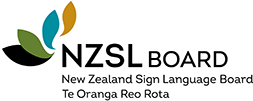The review
9. During 2010, the Office worked with a Deaf advisory group, identifying critical issues and preparing background material for the review.
10. In January 2011, the Minister released a NZSL video announcing the review’s terms of reference and calling for submissions by the end of February 2011. A companion NZSL video setting out the NZSL Act’s provisions and posing questions for feedback on each of these, was released at the same time. The deadline for submissions was extended to 11 April 2011 to take account of disruption resulting from the February 2011 Christchurch earthquake.
11. These videos and their transcripts were placed on the Office for Disability Issues’ website, along with related information about the review. They were also circulated as DVDs and played at consultation meetings. People were asked to send submissions to the Office, either in writing or in NZSL video (on DVD or uploaded to YouTube).
12. Deaf Aotearoa and Deaf Clubs around the country organised consultation meetings with the Deaf community, funded by the Office for Disability Issues. Eighteen consultation meetings were organised for the review. Meetings were held in the following places, and over 177 Deaf people were involved:
- Auckland area (3)
- Christchurch
- Hawkes Bay
- New Plymouth
- Tauranga
- Wellington (2)
- Dunedin
- Kelston (Auckland)
- Palmerston North
- Tokoroa
- Blenheim
- Hamilton
- Nelson
- Rotorua
- Whangarei.
13. The Office received 41 submissions, including NZSL video submissions from community meetings of Deaf people, that were then transcribed for the Office. Eighteen out of the 41 submissions were from individual submitters, the remainder of submissions represented organisations and groups of people.
14. Submissions were received from Deaf organisations, interpreters, academics, advocates, service providers working with Deaf people, family members of Deaf people and Deaf people themselves. While the number of submitters was small, the input from key organisations involved with Deaf people, such as the Human Rights Commission and Deaf Aotearoa, meant that critical issues for Deaf people have been covered. A breakdown of submitters is set out in Appendix 2.
15. The submissions received were analysed to identify the main issues of concern. Because of the qualitative nature of many of the submissions received, it has not been possible (or appropriate) to quantify responses to all of the review questions posed. As few Deaf people have been through the legal system, there were fewer comments on these sections of the NZSL Act. Many responses related to more than one of the questions. Under each of the following sections, some indicative submission responses are quoted or summarised to illustrate the main pattern of responses.
16. The general pattern of responses to the review questions is presented in Appendix 3.
17. Key government agencies providing services used by Deaf people were contacted and asked how they were implementing the NZSL Act, and what their policies and practices were regarding NZSL interpreters for Deaf people seeking their services. These agencies’ responses are set out in Appendix 4.
Page last updated:
